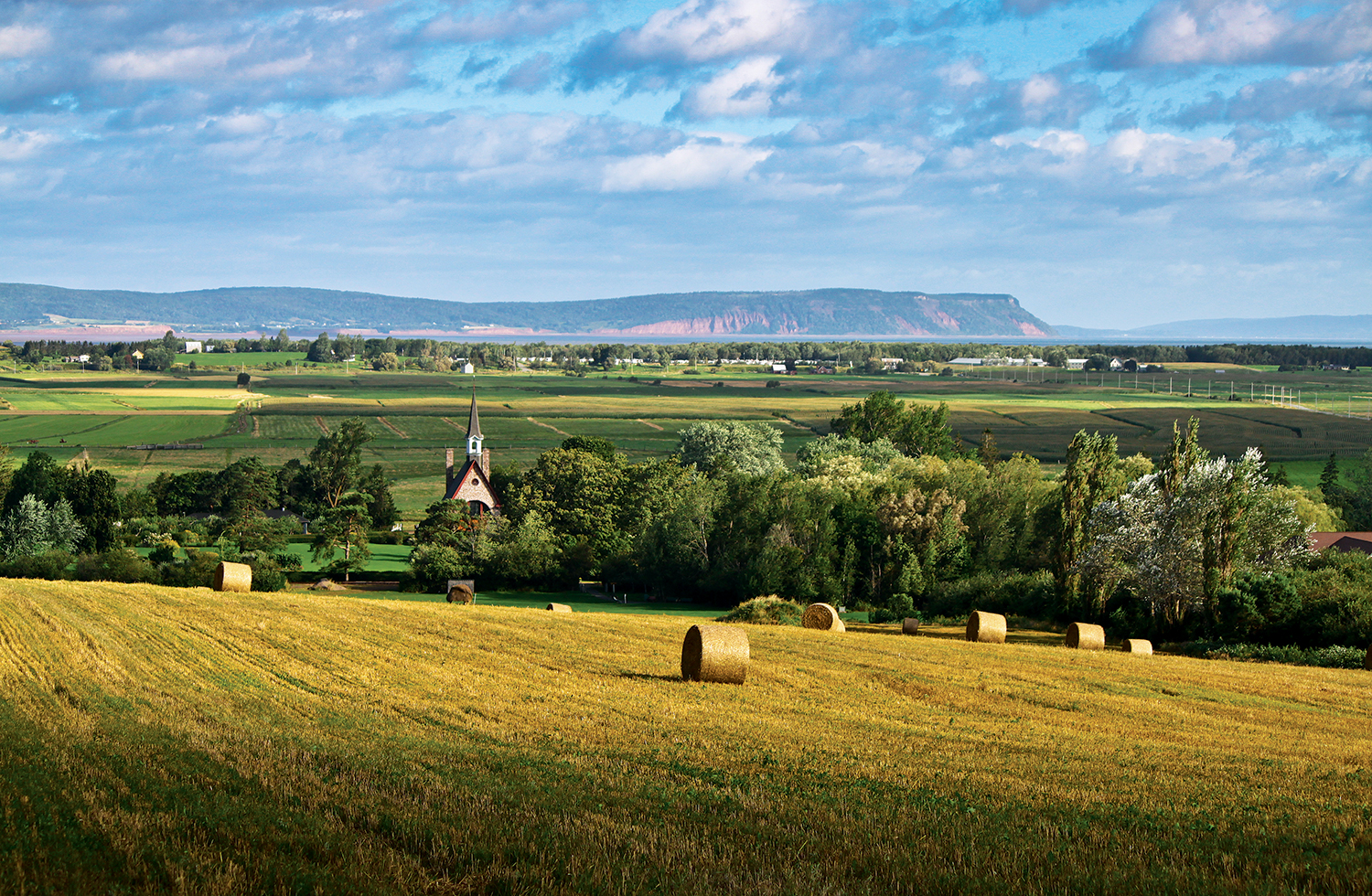Let our local lad show you around the land he loves
By Allan Lynch
Nova Scotia’s Annapolis Valley is a place of superlatives: first, oldest, biggest, highest, largest, greatest. And for the last 251 years, it’s been the place my family has called home.
My father’s family arrived in 1765; my mother’s, in 1763. I am a ninth-generation Bluenoser. Since my office fits in a backpack, I could live anywhere, but I choose to follow family tradition and live here.
The Annapolis Valley starts in Windsor, Hants County, and shadows the coast of the Bay of Fundy south to the town of Digby. Much of the history of Canada begins in or relates to this 166-kilometre-long (103 miles) fertile valley.
Like the Okanagan and Niagara regions, the Annapolis Valley is one of the top fruit-growing areas in Canada, and as in those regions, that fruit heritage has given rise to wineries.
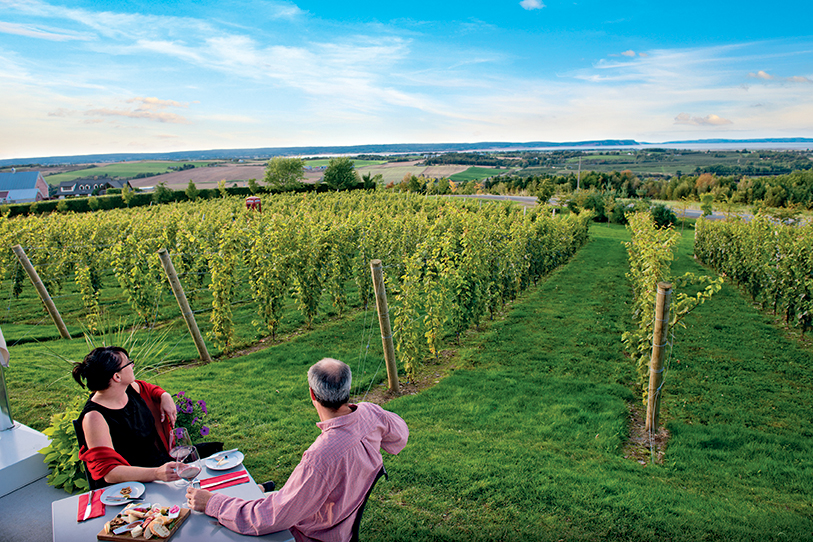
Luckett Vineyards. Photo: Tourism Nova Scotia/Scott Munn.
When we first got into the wine business in the 1970s, the wines were so rough that they were mostly purchased as gifts—something bought to give away but not something to drink yourself. Over time, we learned which grapes grew best in our microclimate (the Valley gets more sunshine and warmer weather than Halifax, an hour’s drive away), and now we have a delicious array of whites, reds, rosés, and sparkling wines.
The wine sector has sparked another evolution as a foodie destination. Cheese makers are many. The Nova Scotia Community College campus in Kentville has a winemaking course and a teaching vineyard. On weekends, a pink double-decker Magic Winery Bus provides a hop-on/hop-off service to six wineries in the Wolfville area. There are organized cycling events to vineyards and, if you’re visiting Halifax, you can join tasting tours to the vineyards. Several, like that owned by celebrity grocer Pete Luckett, have great cafés and restaurants on-site.
Food has become the new recreation—not that we ever shied away from eating. A writer for The New York Times said he had been to many places where people eat to live, but Nova Scotia was the first place he visited where people live to eat.
If you’re a locavore following what you’ve gleaned from the book The 100-Mile Diet, the Annapolis Valley can provide you with a 10-mile diet. This includes farm-fresh produce (vegetables, meat, fruit), seafood (fish, shellfish, dulse—a dried seaweed we snack on), and drink (at least beer and wine…spirits might have to travel 50 miles).
Even Valley festivals and events celebrate food. Summer kicks off on the last weekend of May with the annual Annapolis Valley Apple Blossom Festival. Celebrating all things apple—with Bake-Offs, parades, concerts, and competitions—the festival is complemented by the scent of 10,000 acres of apple orchards in bloom. The town of Kingston, next to CFB Greenwood, has an annual steer barbecue. The eccentric community of Bear River hosts a cherry festival (the village’s reputation as eccentric comes from the many buildings constructed on stilts over the water and the influx of “exotic” summer people, such as the Russian Orthodox priest, Broadway costume designer, early computer creator, and various visual artists who have made it their second home). Digby hosts Scallop Days—hardly surprising, given that it’s home to the world’s largest scallop fleet.
The Birthplace of Hockey
Most visitors to the Valley arrive via Windsor, which is where the superlatives begin. The town is now mostly a bedroom community for Halifax, but in the 18th century, Windsor’s fine homes and cultural life made it a chic place for Londoners (from the UK) to visit, drawn in part by the writings of Windsor’s own Judge Thomas Chandler Haliburton. His extensive works include a series of books (the first, The Clockmaker, was published in 1836) about a Yankee clock peddler called Sam Slick who is responsible for such expressions as “Raining cats and dogs,” “Truth is stranger than fiction,” “Quick as a wink,” and “Barking up the wrong tree.”
During his lifetime, Haliburton was an international best-selling author and one of the most popular humorists working in the English language. His home, Clifton, a.k.a. the Haliburton House Museum, is part of the 26-property Nova Scotia Museum Complex. It is from a reference in Haliburton’s writings that Windsor derives its claim to be the birthplace of hockey. In his diary, Haliburton wrote about students from King’s College playing “hurley on ice” at nearby Long Pond (hurley, or hurling, is an Irish game played with sticks and balls). It was the first such reference; the Windsor Hockey Heritage Centre is on-site at Clifton.

The Windsor Pumpkin Regatta. Photo: Tourism Nova Scotia/Wally Hayes.
Windsor is also home to the Giant Pumpkin. Great gourd growing started here in the 1970s when local farmer Howie Dill developed the Atlantic Giant Pumpkin seed. In addition to the annual Windsor-West Hants Pumpkin Weigh-off is the Pumpkin Regatta, held in mid-October. Lone competitors and teams race hollowed-out pumpkins across Lake Pisiquid. It’s just one more way we play with our food.
Proceeding west along the Trans-Canada Highway, the view from the Avonport overpass tells those of us who were born and/or live here that we are home. It’s where the Valley opens up ahead of us. Straight ahead, glimmering in the sunlight, are the domes of a couple of farm silos above a stand of trees and the gentle green fields. On the right, depending on the tides, we see either the waters or the mud flats of the Minas Basin. Beyond them is Cape Blomidon, a headland that acts as a buffer between the Minas Basin and the Bay of Fundy.
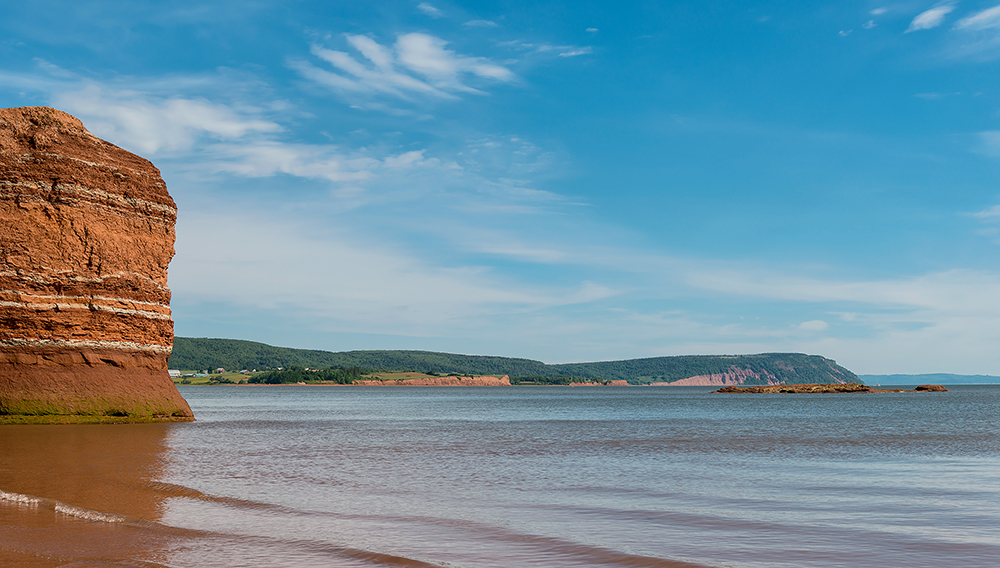
The sandstone cliffs of Cape Blomidon on the Minas Basin. Photo: iStock/PetrovVadim.
The Minas Basin has the world’s highest tides (there can be as much as a 16 metre/52.5 foot difference between high and low) and the Bay of Fundy has the world’s greatest tides. Twice a day, 100 billion tonnes (110 billion tons) of water flows up the Bay and into the Basin. These tides are equal to all the water in all the world’s freshwater rivers. They are so great that they would fill the Grand Canyon one-and-a-half times and take more than a month to flow over Niagara Falls.
The Great Deportation
After Avonport, with its welcoming view, a visitor’s first must-stop is Grand Pré National Historic Site. French farmers settled Grand Pré in 1680 because the land was so fertile. Working by hand with a few oxen, the French, known as Acadians, built dikes to reclaim more than 1,200 hectares (3,000 acres) of land for farming. Because this area is the longest continuously farmed part of North America, UNESCO named it a World Heritage Site.
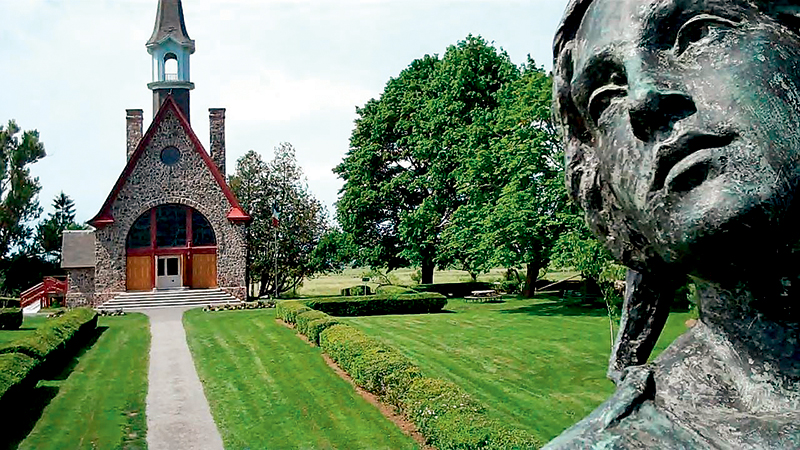
Evangeline in front of a replica of the parish church of St-Charles-des-Mines, Grand Pré. Photo: Allan Lynch.
The second reason for Grand Pré’s UNESCO status was the Expulsion of the Acadians (also known as the Great Deportation), beginning in 1755, by the British. For centuries, the French and English battled for control of the New World colonies. While the Acadians were neutral, the fact that the French pressed some into service at Fort Beauséjour made the outnumbered British nervous. The British governor sent troops to Grand Pré, the main Acadian village, to ask the Acadians to swear allegiance to the British Crown. When the Acadians refused, the British deported them.
It took several years, but more than 10,000 Acadians from across what are now the Maritimes were scattered to Europe, along the Eastern Seaboard, and as far away in North America as Louisiana. In Louisiana, the Acadians dropped the A and became Cajuns. Grand Pré is, in essence, the root of Cajun culture.
Longfellow’s epic poem Evangeline is about star-crossed lovers—Evangeline and Gabriel—separated by the deportation, and at the entrance to the Grand Pré National Historic Site is a statue to Evangeline. A study of her face tells the story of two women. The profile facing skyward basks in the sunshine of youth, while the profile looking down shows a woman worn by hardship and sorrow. It’s a visual haiku for the history of a place and a people.
Next to Grand Pré is the university town of Wolfville (3,800 permanent residents, plus 3,800 students). Wolfville is another of the property-proud towns that line the Valley. Like others, it has a Main Street bordered by grand mansions. Some are still privately owned, while others have been converted into B & B’s and inns. Art lovers may know Wolfville as home to the late realist painter Alex Colville. It’s also home to Acadia University. Given its 17 cafés, restaurants, and pubs, I consider it Nova Scotia’s culinary capital.
Wolfville also has a great Saturday Farmers’ Market that is both an event and a shopping experience. It’s a great place to come for lunch. Plus, in spring, summer, and fall, it hosts a Wednesday evening community dinner with food vendors offering German, Italian, Mediterranean, Middle Eastern, Ethiopian, and Asian foods.
The market illustrates another great Valley asset: the opportunity to dine locally at all kinds of community events. Three Saturday mornings a month, a group of us gather for our Breakfast Club, making the rounds of the various all-you-can-eat breakfasts organized by local service clubs and auxiliaries. For example, the New Minas Lions Club holds breakfast at the community centre on the first Saturday of the month. The Wolfville Lions Club and Royal Canadian Legion branch in Wolfville also host breakfasts (the Legion has table service and a choice of eggs). And on the third weekend of the month, we go to the St. James Anglican Church breakfast in Kentville, just 10 kilometres (six miles) away. The Anglicans charge a dollar more but have fish cakes.
Resident or visitor, the breakfasts, lunches, teas, and dinners organized by local volunteers using old recipes are a perfect way to enjoy a real home-cooked meal while travelling. Check Valleyevents.ca for a good weekly summary.
Kentville is the regional financial centre. A 20-minute drive from Kentville to the Bay of Fundy coast takes you to the fishing port of Hall’s Harbour. Six metres (20 feet) from the boats that land them is a pound full of lobsters. Point to the lobster you want and soon you’re sitting beside those boats dining on the freshest catch possible.
I like to come here at low tide to explore the pools of water amid the rocks. They’re like little natural aquariums filled with bright starfish, seaweed, and occasionally fish that the gulls haven’t scooped up.

The tidal extremes of Hall’s Harbour. Photos: Tourism Nova Scotia/Wally Hayes.
Hall’s Harbour is an easy place to see and understand the tides. At low tide, those boats not out fishing will be sitting on mud and rocks six or seven metres (20–23 feet) below street level; at high tide, they’re level with the wharf. When I was little, my father owned a cab and tour company and would bring visitors here at high and low tide to show them the difference. More than once, he was accused of taking them to two separate places. Outsiders couldn’t believe the difference in ground level.
The Order of Good Cheer
The Valley is so full of history that it’s impossible to capture it all in one magazine article.
Two key stops are the Habitation at Port Royal and Annapolis Royal, which represent a cluster of superlatives. Annapolis Royal (population: 481) is the former colonial capital. The streets are lined with the most gorgeous eccentric Georgian and Victorian mansions, many of which are today B & B’s and inns. The small downtown is a national historic district lined with a collection of interesting and poky shops, galleries, cafés, and restaurants. At one end of George Street is Fort Anne. This earthen star-shaped fort contains one of the two copies of the Royal Charter of Nova Scotia. The other is in Edinburgh Castle.
At the far end of the street is an area where an outdoor weekly farmers’ and traders’ market is held. It’s one of the top markets in the province, with food, crafts, arts, antiques, and music. It’s a great place to find both personal treats and souvenir hunting.
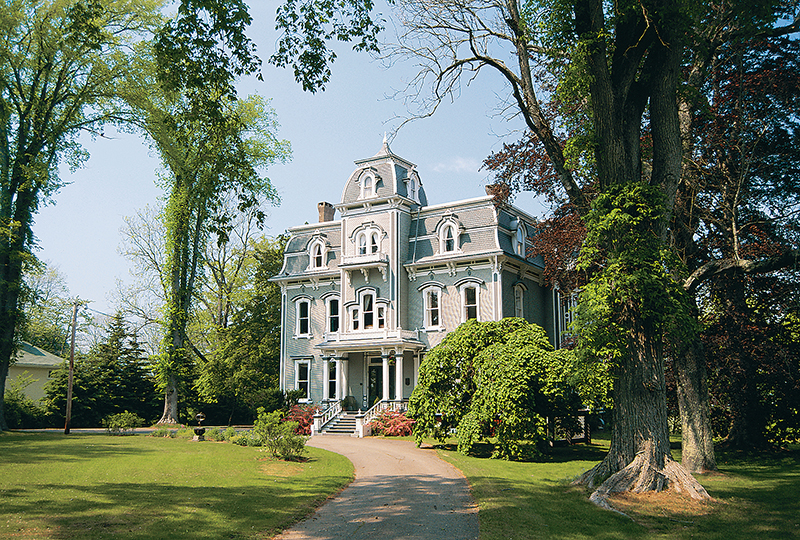
The Queen Anne Inn, Annapolis Royal. Annapolis Royal Historic Gardens. Photo: Tourism Nova Scotia.
Annapolis Royal has several other museums, historic gardens, and a lively arts council that arranges concerts, live theatre, and an annual paint-the-town event that encourages artists to set up their easels anywhere and everywhere to paint and sketch their surroundings and then sell their work at the community gallery. For those travelling with kids, there’s the nearby Upper Clements Park, a wildlife and amusement facility. There are also a variety of themed walking tours, including an extremely popular evening Graveyard Tour given by a costumed guide. Another popular event is the Natal Day mock battle (held during the August long weekend), with musket and cannon fire and presented by costumed re-enactors who camp at Fort Anne.
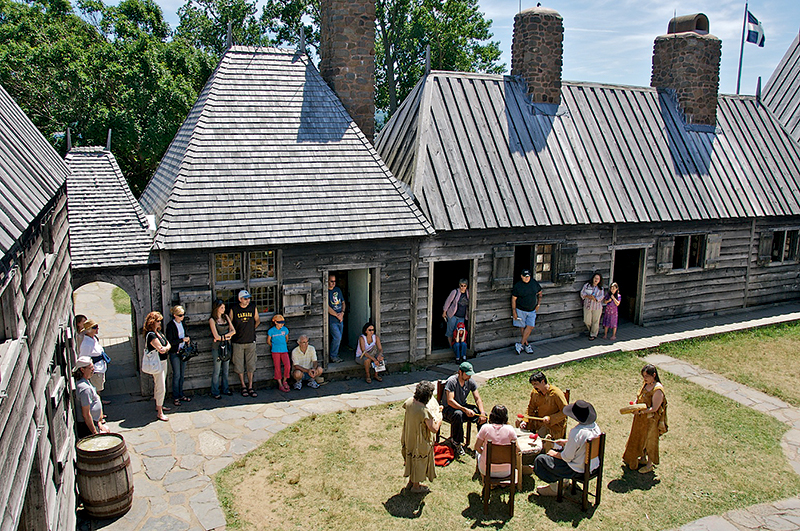
Fort Anne. Photo: Port Royal National Historic Site.
The mock battle hints at the area’s bloody history. While the British were burrowed in Fort Anne, the French held firm at the Habitation across the bay in Port Royal. In 1605, the French established the first permanent European settlement north of St. Augustine, Florida, making it also the first permanent European settlement in Canada. It was founded by the Sieur de Monts, who lacks the historical profile of his famous cartographer, Samuel de Champlain.
To maintain the spirits of the men, Champlain founded The Theatre of Neptune, North America’s first theatre company. He also founded a dining club called the Order of Good Cheer: each gentleman took a turn organizing, supplying, and preparing a dinner for the others at the Habitation. This occupied the residents and launched our 400-year tradition of hospitality.
The final must-see Valley stop is Digby. Once the home of Thomas Edison, Digby has a lovely old railway resort, Digby Pines. The resort has a Norman-style château main building and a cluster of two-bedroom cottages with working fireplaces spread across a campus overlooking Digby Gut (a body of water). The Pines also has a Stanley Thompson-designed golf course. Overlooked by most visitors, this is a classic course that is fun to play, whatever your abilities. It’s a sister course to such Thompson masterpieces as Banff Springs and the Highlands Links. Digby is also a great base for whale-watching tours on the Bay of Fundy.
The Annapolis Valley is a small place with a lot to see, do, taste, and experience. Come see what some of us have been enjoying for centuries.


